You know that moment when you think you've tried every Filipino ulam there is? That was me until I discovered Ilocano Igado! I initially thought it was just another version of adobo (I mean, there's soy sauce and vinegar, right?), but oh boy, was I wrong.
This dish completely changed my weekend lunch game. The way the tender pork and liver come together with that perfectly balanced sauce, it's like adobo's mysterious, more sophisticated cousin that went abroad and came back extra special.
As someone who grew up thinking organ meats were just 'okay lang,' this igado recipe made me realize why my Ilocana officemate would light up whenever Igado was mentioned. Even my kids, who usually do the "eww, atay" drama, now fight over the last piece.
What is Igado?
Igado is an Ilocano cornerstone dish where pork tenderloin meets liver in a bold vinegar-soy braise. This thrifty yet sophisticated stew marries tender meat strips with crisp bell peppers and sweet peas, all swimming in a deeply savory sauce. At its heart, it's working-class Filipino ingenuity - transforming humble ingredients into pure comfort through time-tested technique.
Jump to:
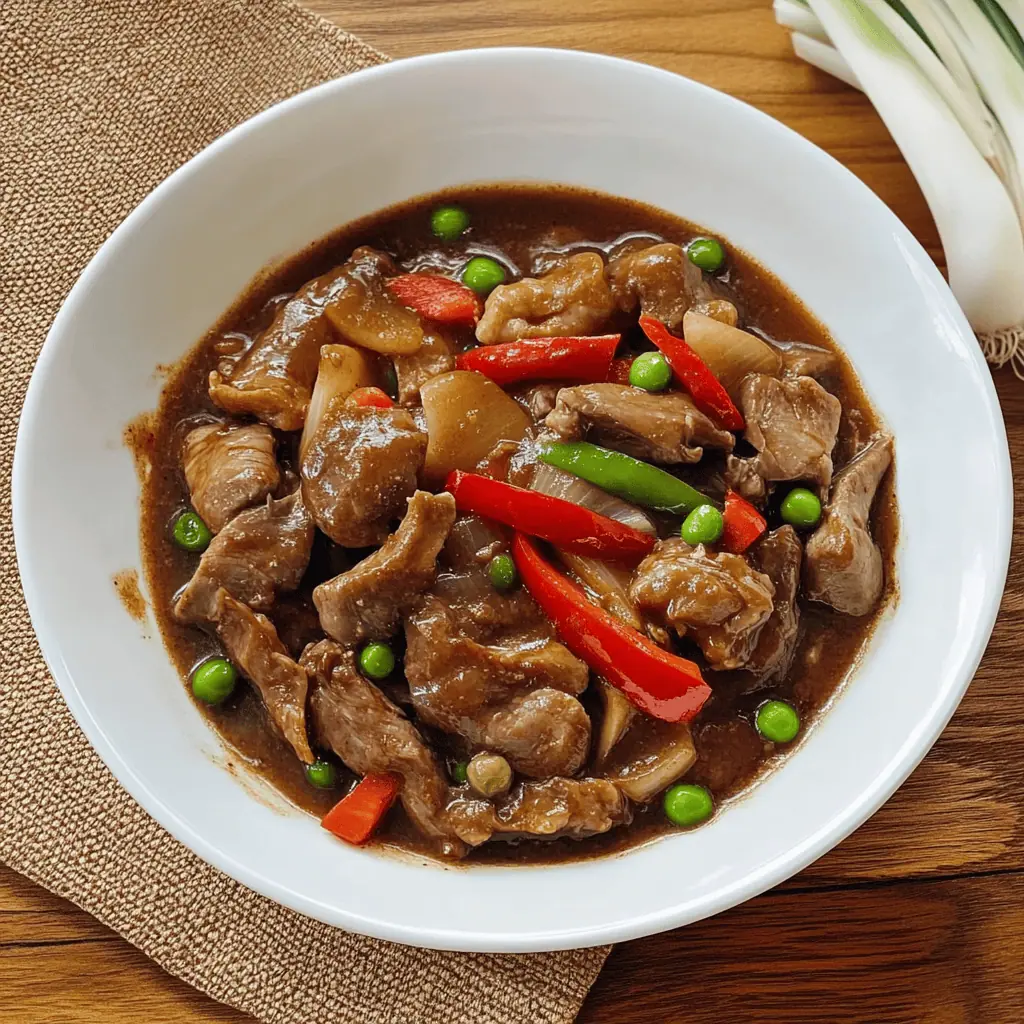
Why You'll Love This Recipe
- Perfect Balance: Master the signature tangy-savory flavor profile that makes Igado addictive
- Budget-Friendly: Transform affordable ingredients into a gourmet dish
- Make-Ahead Friendly: Tastes even better the next day
- Nutritious: Rich in protein, iron, and vitamins
- Authentically Ilocano: Preserves traditional cooking methods while adding modern precision
- Versatile: Works as both everyday ulam or special occasion dish
Ingredients
Each ingredient in Igado plays a vital role in creating its distinctive flavor profile. The tender pork provides the dish's foundation, while liver adds richness and depth. Vinegar and soy sauce create the perfect tangy-savory balance, with garlic and onions building aromatic complexity.
Bay leaves and peppercorns add subtle warmth, while bell peppers and peas bring color, texture, and a touch of sweetness that balances the robust flavors of the meat and marinade.
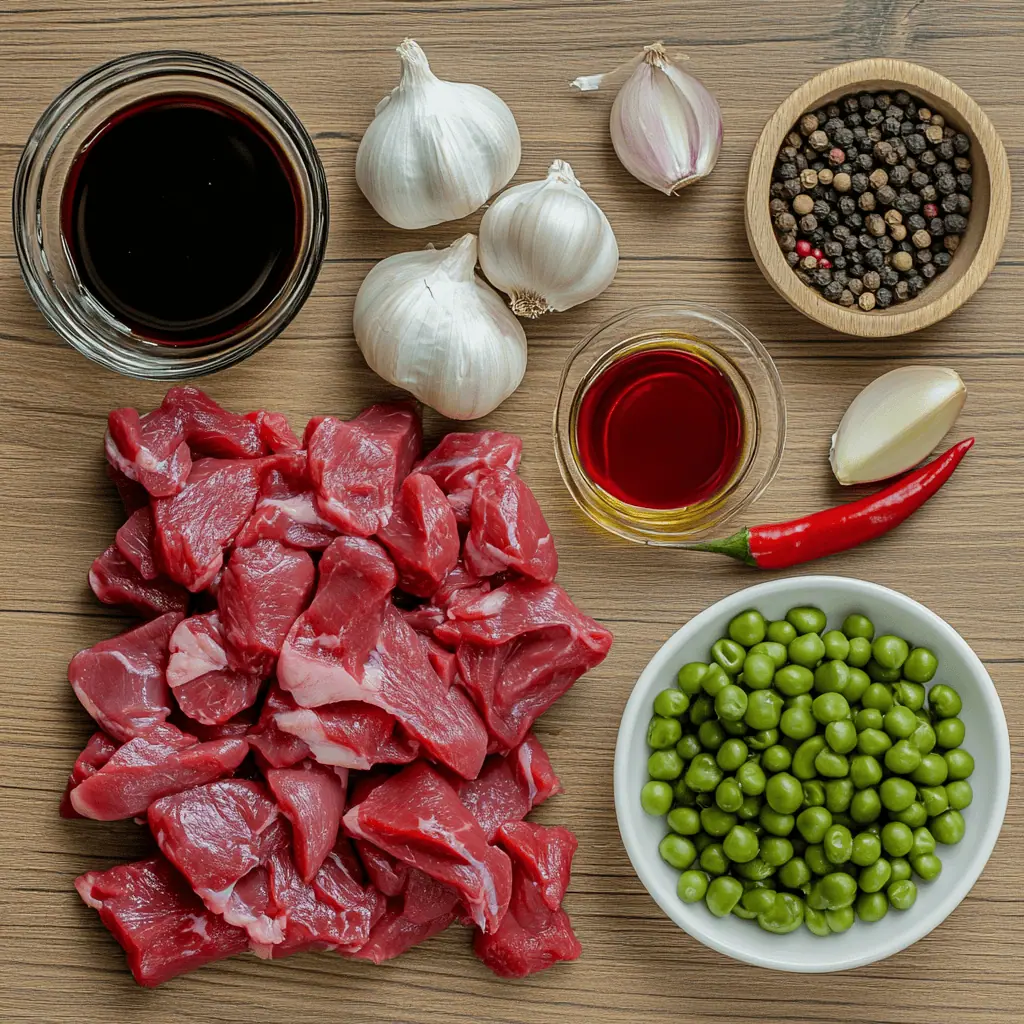
For the Meat:
- 1 pound pork tenderloin, cut into ½-inch strips
- 1 pound beef liver, cut into ½-inch strips
For the Marinade:
- ½ cup vinegar
- ¼ cup soy sauce
- 4 cloves garlic, minced
- 1 medium onion, thinly sliced
- 2 bay leaves
- ½ teaspoon cracked black peppercorns
For the Vegetables:
- 1 small red bell pepper, cut into strips
- ½ cup green peas
- 1 tablespoon cooking oil
Equipment
- Large mixing bowl - For marinating the meat, ensuring even flavor distribution throughout
- Sharp knife - Essential for achieving the clean, thin cuts of meat that define authentic Igado
- Cutting board - Provides a stable surface for precise cutting of ingredients
- Large skillet or wok (Kawali) - For proper stir-frying and even heat distribution
- Measuring cups and spoons - Ensures accurate measurements for consistent results
- Tongs - For gentle handling of meat pieces without breaking them
- Airtight container - For storing leftovers to maintain freshness
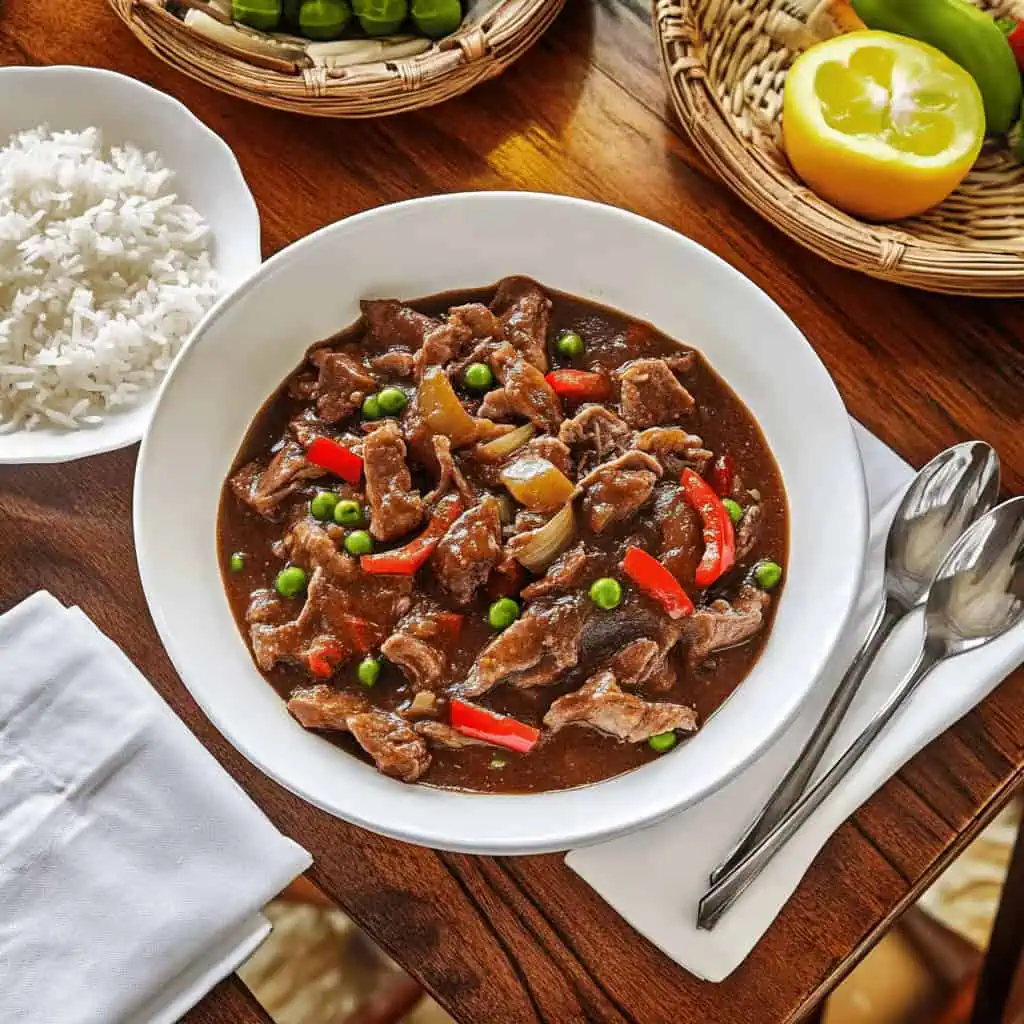
How To Make
- Prepare your ingredients - Cut the pork tenderloin and beef liver into half-inch strips. Thinly slice the onion and mince the garlic. Cut the red bell pepper into strips. Set aside the green peas.
- Marinate the meat - In a large glass or non-reactive bowl, combine the sliced pork with vinegar, soy sauce, sliced onions, minced garlic, bay leaves, and cracked black peppercorns. Let the meat marinate at room temperature for 20 minutes.
- Separate marinated items - After marination, drain the meat but save the marinade liquid and aromatics separately. You will need these later for the sauce.
- Cook the vegetables - Heat your cooking oil in a large, heavy-bottomed pan over medium-high heat. When the oil is hot, quickly stir-fry the bell pepper strips for 30 seconds until they slightly blister. Remove the peppers and set them aside.
- Cook the pork - Using the same pan and oil, add the marinated pork (not the liver yet). Cook until the meat changes color from pink to light brown, about 5 minutes. Add the reserved onions, garlic, peppercorns, and bay leaves from the marinade. Continue cooking until the onions become soft and translucent.
- Develop the sauce - Pour in the reserved marinade liquid and bring it to a full boil over high heat. This is a crucial step - do not stir the mixture for 4-5 minutes after it starts boiling. This technique, called pagpapakulo ng suka, helps develop the sauce's flavor.
- Simmer the pork - Add half a cup of water to the pan and bring the mixture back to a boil. Once boiling, lower the heat to medium-low, cover the pan, and let it simmer for 25-30 minutes. The pork should become tender during this time.
- Add the liver - When the pork is tender, add the liver strips to the pan, maintaining medium heat. Gently stir the liver and cook for 4-5 minutes until just done. The liver should still be slightly pink inside to remain tender.
- Finish with vegetables - Add the green peas to the pan and cook for 2-3 minutes until they turn bright green. Return the reserved bell peppers to the pan and cook for another 1-2 minutes to heat them through.
- Final adjustments - Taste the sauce and adjust the seasoning with salt if needed. Remove the bay leaves before serving.
- Rest before serving - For the best results, let the igado rest for 5-10 minutes before serving. This resting period allows the flavors to settle and the meat to reabsorb some of the sauce.
- Serve - Serve your igado hot with steamed white rice. Traditional accompaniments include pickled green papaya (atchara), sliced fresh tomatoes, and fish sauce (patis) on the side.

Tips from Lola's Kitchen
- Choose quality liver - Look for fresh, pinkish-red liver without strong odors for the best flavor
- Cut meat against the grain - This simple technique dramatically improves tenderness
- Respect the undisturbed boil - Don't skip the undisturbed boiling of the vinegar mixture - this crucial step develops depth of flavor
- Size matters with liver - Keep liver pieces slightly larger as they shrink during cooking
- Fresh citrus finish - Add a splash of calamansi juice at the end for authentic Filipino brightness
- Balanced marination - Don't marinate the liver with the pork - it absorbs flavors much faster
- Temperature control - Use medium heat when cooking liver to prevent it from becoming tough
- Resting period - Always allow the finished dish to rest for 5-10 minutes before serving
Substitutions
- Protein options - Replace pork tenderloin with pork belly for a richer version
- Liver alternatives - Substitute beef liver with chicken liver for a milder flavor (reduce cooking time to 2-3 minutes)
- Vegetable swaps - Use snap peas instead of green peas, or add carrots for extra sweetness
- Bell pepper alternatives - Replace bell peppers with mild long peppers for authentic Northern flavor
- Vinegar varieties - Use apple cider vinegar instead of white vinegar for a more mellow acidity
- Soy sauce options - Try light soy sauce if you prefer a less intense color
Troubleshooting
Tough Liver:
- Problem: Liver becomes rubbery and unpleasant
- Solution: Don't overcook; add liver during the final minutes and keep it slightly pink inside
- Prevention: Use medium heat and watch timing carefully
Watery Sauce:
- Problem: Sauce lacks richness and clings poorly to meat
- Solution: Simmer uncovered for the last 5-10 minutes to reduce and concentrate flavors
- Prevention: Don't add too much water during the cooking process
Too Sour:
- Problem: Vinegar flavor dominates and overwhelms other notes
- Solution: Add ½ teaspoon sugar to balance acidity, or a bit more soy sauce for umami
- Prevention: Use the right vinegar-to-soy sauce ratio (2:1)
Dry Meat:
- Problem: Pork becomes tough and stringy
- Solution: Add a little more liquid and simmer longer on low heat
- Prevention: Don't slice pork too thinly and don't overcook
Liver Has Strong Smell:
- Problem: Liver imparts a strong metallic taste to the dish
- Solution: Soak liver in milk for 30 minutes before cooking
- Prevention: Choose fresh liver and handle it properly
Storage & Reheating
Refrigeration:
- Store in an airtight container for 3-4 days
- The flavor actually improves after 24 hours as ingredients meld
Freezing:
- Freeze for up to 2 months in freezer-safe containers
- Best to exclude bell peppers if planning to freeze
- Thaw overnight in refrigerator before reheating
Reheating Methods:
- Stovetop (Best Method): Reheat on medium-low heat with a splash of water to maintain moisture
- Microwave: Heat in 30-second intervals, stirring between each, until warmed through (2-3 minutes total)
- Add freshness: Squeeze fresh calamansi juice over reheated igado to revive flavors
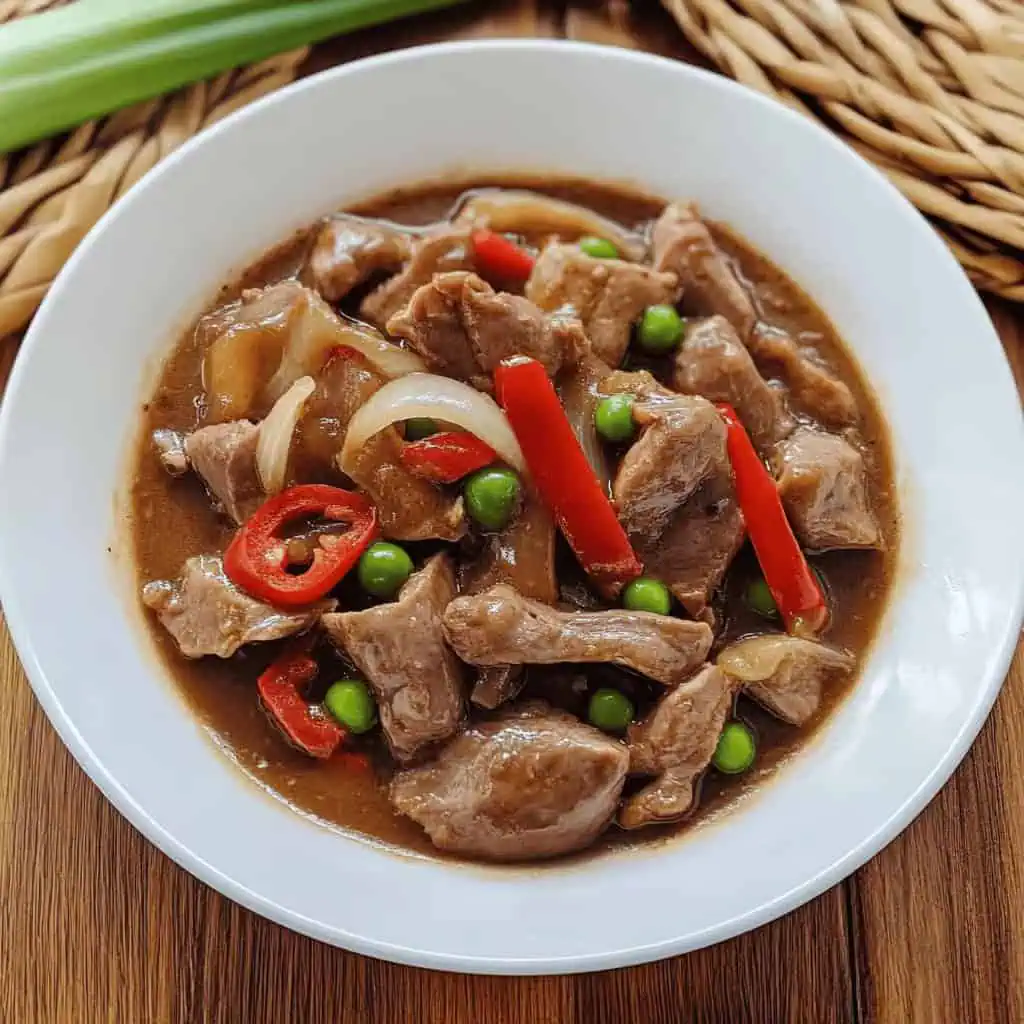
FAQ
Can I use other types of liver?
Yes, chicken liver works well but reduces cooking time to 2-3 minutes. Pork liver is also traditional in some regions.
Why is my sauce too dark?
You may be using too much soy sauce or cooking it too long. Reduce soy sauce amount or use light soy sauce.
Can I make it ahead for parties?
Absolutely! The flavors actually improve overnight. Store in the refrigerator and reheat gently before serving.
How do I reduce the liver's strong taste?
Soak liver in milk for 30 minutes before cooking. The calcium helps neutralize the metallic flavor.
Is this recipe freezer-friendly?
Yes, freeze without bell peppers for up to 2 months in airtight containers.
Can I add other vegetables?
Yes! Traditional variations include carrots, patani (lima beans), or mushrooms.
What if I don't like liver at all?
While liver is traditional, you can make a modified version using all pork and adding a splash of liquid smoke for depth.
How spicy should authentic igado be?
Traditional igado is savory rather than spicy, but you can add Thai chilies if you prefer heat.
Can I make a bigger batch for meal prep?
Absolutely! The recipe doubles well, and the flavors improve with time.
What makes this dish different from Menudo?
Igado features a tangier flavor profile and uses more liver. Menudo typically includes potatoes and has a tomato-based sauce.
Related
Looking for other recipes like this? Try these:
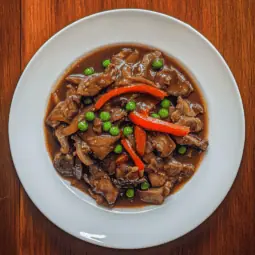
Authentic Ilocano Igado (Pork and Liver Stew)
Equipment
- Large mixing bowl (Malaking mangkok)
- Sharp knife [Matalas na kutsilyo]
- Cutting board
- Large skillet or wok (Kawali)
- Measuring cups and spoons (Panukat)
- Tongs [Sipit]
Ingredients
For the Meat
- 1 pound pork tenderloin cut into ½-inch strips
- 1 pound beef liver atay, cut into ½-inch strips
For the Marinade (Pampaanghang)
- ½ cup vinegar suka
- ¼ cup soy sauce toyo
- 4 cloves garlic bawang, minced
- 1 medium onion sibuyas, thinly sliced
- 2 bay leaves dahon ng laurel
- ½ teaspoon cracked black peppercorns dinurog na paminta
For the Vegetables
- 1 small red bell pepper pulang siling pang-ulam, cut into strips
- ½ cup green peas gisantes
- 1 tablespoon cooking oil mantika
Instructions
- First, prepare your ingredients. Cut the pork tenderloin and beef liver (atay) into half-inch strips. Thinly slice the onion (sibuyas) and mince the garlic (bawang). Cut the red bell pepper into strips. Set aside the green peas (gisantes). This preparation is called "mise en place".
- In a large glass or non-reactive bowl, combine the sliced pork with vinegar (suka), soy sauce (toyo), sliced onions, minced garlic, bay leaves (dahon ng laurel), and cracked black peppercorns (dinurog na paminta). Let the meat marinate at room temperature (27°C/80°F) for 20 minutes. This process is called pagpapaalat.
- After marination, drain the meat but save the marinade liquid and aromatics separately. You will need these later for the sauce (sarsa).
- Heat your cooking oil (mantika) in a large, heavy-bottomed pan over medium-high heat (180°C/350°F). When the oil is hot, quickly stir-fry the bell pepper strips for 30 seconds until they slightly blister. Remove the peppers and set them aside.
- Using the same pan and oil, add the marinated pork (not the liver yet). Cook until the meat changes color from pink to light brown, about 5 minutes. Add the reserved onions, garlic, peppercorns, and bay leaves from the marinade. Continue cooking until the onions become soft and translucent (malinaw).
- Pour in the reserved marinade liquid and bring it to a full boil over high heat (100°C/212°F). This is a crucial step - do not stir the mixture for 4-5 minutes after it starts boiling. This technique, called pagpapakulo ng suka, helps develop the sauce's flavor.
- Add half a cup of water to the pan and bring the mixture back to a boil. Once boiling, lower the heat to medium-low (160°C/320°F), cover the pan, and let it simmer for 25-30 minutes. The pork should become tender during this time (dapat lumambot ang karne).
- When the pork is tender, add the liver strips to the pan, maintaining medium heat (170°C/340°F). Gently stir the liver and cook for 4-5 minutes until just done. The liver should still be slightly pink inside to remain tender (dapat medyo pink pa sa loob).
- Add the green peas to the pan and cook for 2-3 minutes until they turn bright green. Return the reserved bell peppers to the pan and cook for another 1-2 minutes to heat them through.
- Taste the sauce and adjust the seasoning with salt (asin) if needed. Remove the bay leaves before serving.
- For the best results, let the igado rest for 5-10 minutes before serving. This resting period allows the flavors to settle and the meat to reabsorb some of the sauce.
- Serve your igado hot with steamed white rice (mainit na kanin). Traditional accompaniments include pickled green papaya (atchara), sliced fresh tomatoes (kamatis), and fish sauce (patis) on the side.
- Store any leftovers in an airtight container in the refrigerator (4°C/40°F) for up to 3-4 days. When reheating, add a few tablespoons of water and warm over medium heat (160°C/320°F) until heated through, or microwave in short intervals, stirring occasionally to ensure even heating.
Tips from Lola's Kitchen
- Choose fresh, pinkish-red liver without strong odors
- Cut meat against the grain for tenderness
- Don't skip the undisturbed boiling of vinegar mixture
- Keep liver pieces slightly larger as they shrink during cooking
- Add a splash of calamansi juice at the end for authentic Filipino taste
Nutrition
The Story Behind Authentic Ilocano Igado (Pork and Liver Stew)
In the sun-soaked kitchens of Ilocos, where Spanish colonial influence meets Ilocano ingenuity, Igado emerged as a testament to our ancestors' resourceful cooking. The name itself tells a story - derived from the Spanish word "hígado" (meaning liver), but transformed into something uniquely Filipino through generations of home cooks and family gatherings.
Unlike its distant Spanish cousins, Ilocano Igado evolved into a dish that celebrates, rather than masks, the rich flavors of organ meats. Our ancestors, masters of zero-waste cooking long before it became trendy, transformed humble ingredients like pork liver and tenderloin into a dish so sophisticated it became a staple at both family tables and grand fiestas. The addition of vinegar - a signature of Northern Luzon cuisine - wasn't just for flavor; it was our grandmothers' way of preserving meat in the days before refrigeration.
What sets authentic Igado apart from other Filipino menudencia dishes is its distinctive preparation method. The meat isn't just chopped; it's cut into precise, matchstick-sized pieces (a technique Ilocanos call "ini-ini"), allowing each morsel to absorb the perfect balance of vinegar and soy sauce. This preparation style, passed down through generations of Ilocano kitchens, ensures that every bite delivers that perfect harmony of flavors that makes Igado uniquely Ilocano.
Today, while modern Filipino cuisine continues to evolve, Igado remains a proud symbol of Ilocano culinary heritage. From the humble carinderias of Vigan to the modern restaurants of Metro Manila, this dish continues to tell the story of Ilocano resourcefulness and creativity. Whether served during special occasions or as a treasured weekly ulam, Igado reminds us that some of our most beloved dishes come from our ancestors' ability to transform simple ingredients into extraordinary meals.
Like many cherished Filipino recipes, every family has their own Igado story. Some add carrots for sweetness, others swear by a specific vinegar-to-soy sauce ratio, but all agree that the heart of Igado lies in its ability to bring families together around the table, sharing not just a meal, but a piece of our cultural heritage.
Remember: Perfect Igado isn't just about the ingredients—it's about achieving that ideal balance where the vinegar brightens but doesn't overwhelm, and each piece of meat and organ is tender yet maintains its distinct texture and flavor.
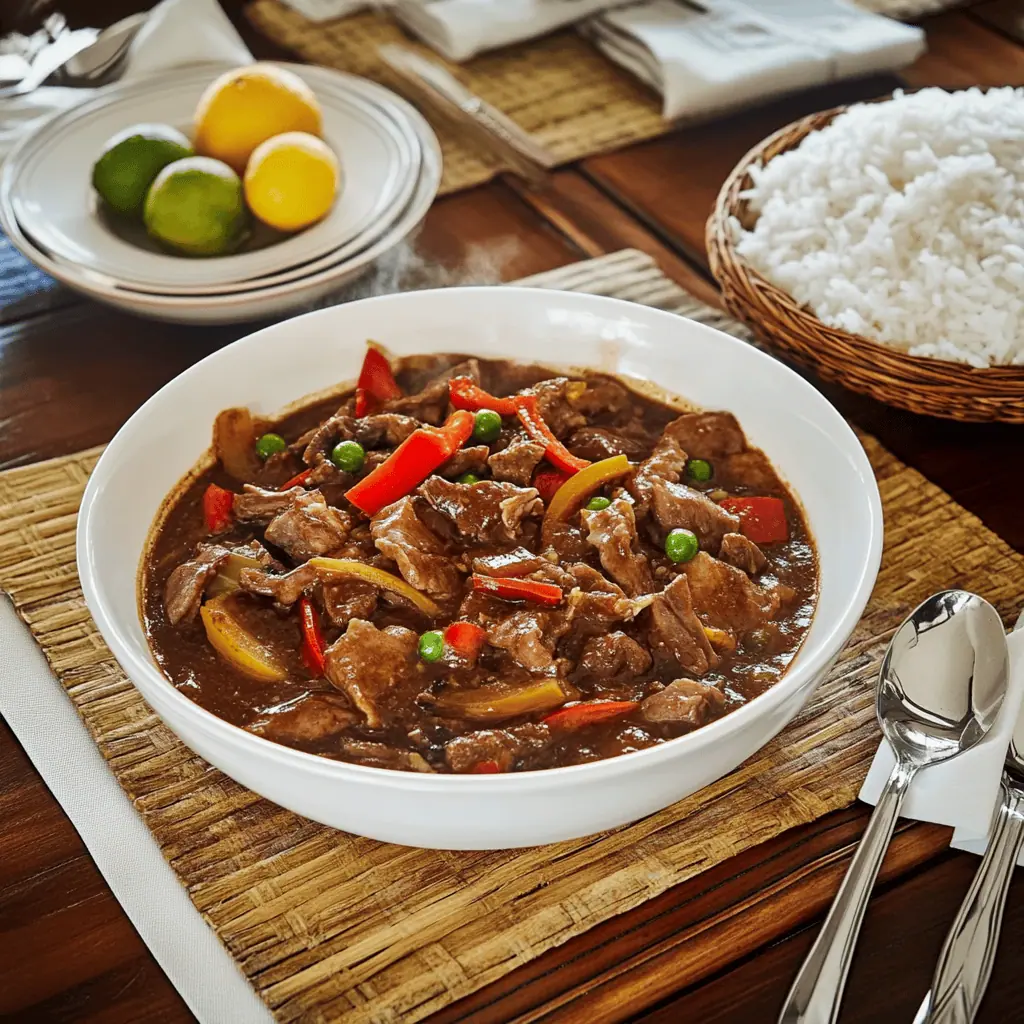









Comments
No Comments